A team of archaeologists from the Çanakkale Onsekiz Mart University have uncovered a 1700-year-old trident in the ancient city of Assos.
Assos was an Ancient Greek city located on the Aegean coast in the present-day Çanakkale province of Turkey. The city was founded by Aeolian colonists between 1000 to 900 BC, emerging as a major centre of philosophy under the school of Aristotle.
According to Christian tradition, St. Paul visited the city during his third missionary journey (AD 53-57 AD) through Asia Minor on his way to Mytilene. Acts 20 records that Luke the Evangelist and his companions (‘we’) “went ahead to the ship and sailed [from Troas] to Assos, there intending to take Paul on board … and when he met us at Assos, we took him on board and came to Mitylene”.
Recent excavations have unearthed a trident harpoon among pieces of a collapsed vault from a Nymphaion, a structure used for distributing water typically from aqueducts.
Trident’s served various purposes, such as spearfishing, and its historical use as a polearm. In classical mythology, the trident is associated with Poseidon in Greek mythology and Neptune in Roman mythology, symbolising their dominion over the sea.
In Ancient Rome, tridents were also used by a type of gladiator called a retiarius or “net fighter”. The retiarius was traditionally pitted against a secutor, and cast a net to wrap his adversary and then used the trident to spear them.
According to the researchers, the trident is made from iron and dates from around 1700-1800-years-ago. Such discoveries are rare, which are normally found in contemporary depictions on ceramics and frescos showing fisherman harpooning fish with tridents.
According to Prof. Dr. Arslan, there is evidence of iron working at Assos, so its possible that the object may have been produced locally. Because iron objects generally oxidise, the discovery is the first example found by archaeologists during their excavations at Assos.
The object has been sent for preservation by separating the soil or oxidised parts, and then will have protective materials applied to present further oxidation of the iron.
Header Image Credit : Çiğdem Münibe Alyanak





